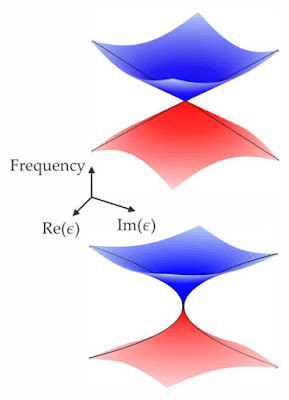 |
| Image Source: Link below |
A ring-shaped optical cavity has degenerate resonant modes, because clockwise and anticlockwise waves resonate at the same frequencies. The degeneracy can be lifted, and the frequencies split, by a perturbation such as a physical rotation or the presence of a molecule or nanoparticle. Typically, the frequency splitting is proportional to the perturbation’s magnitude, as illustrated in the top panel of the figure for a hypothetical complex-valued perturbation ε (that is, one that can affect both the light’s frequency and its phase). Because the plot’s shape resembles a yo-yo-like toy called a diabolo, the degeneracy has been dubbed a diabolic point. The mode splitting around a diabolic point is the basis for optical gyroscopes, and it’s been explored for other sensing applications.
There’s another type of degeneracy, called an exceptional point, where not only do resonant frequencies coincide but their resonant modes do too. In the case of the ring resonator, inserting reflectors to scatter light from the anticlockwise mode into the clockwise mode (but not vice versa) creates an exceptional point with a single resonant mode, the clockwise-traveling wave. Perturbing the system splits that mode into two resonances, each with a small admixture of the anticlockwise wave, and the frequency splitting scales with the square root of the perturbation magnitude, as shown in the bottom panel.
Exceptional points make for exceptional sensorsAt just the right locations in parameter space, resonant frequencies are ultrasensitive to tiny changes.Johanna L. Miller, Physics Today
Comments